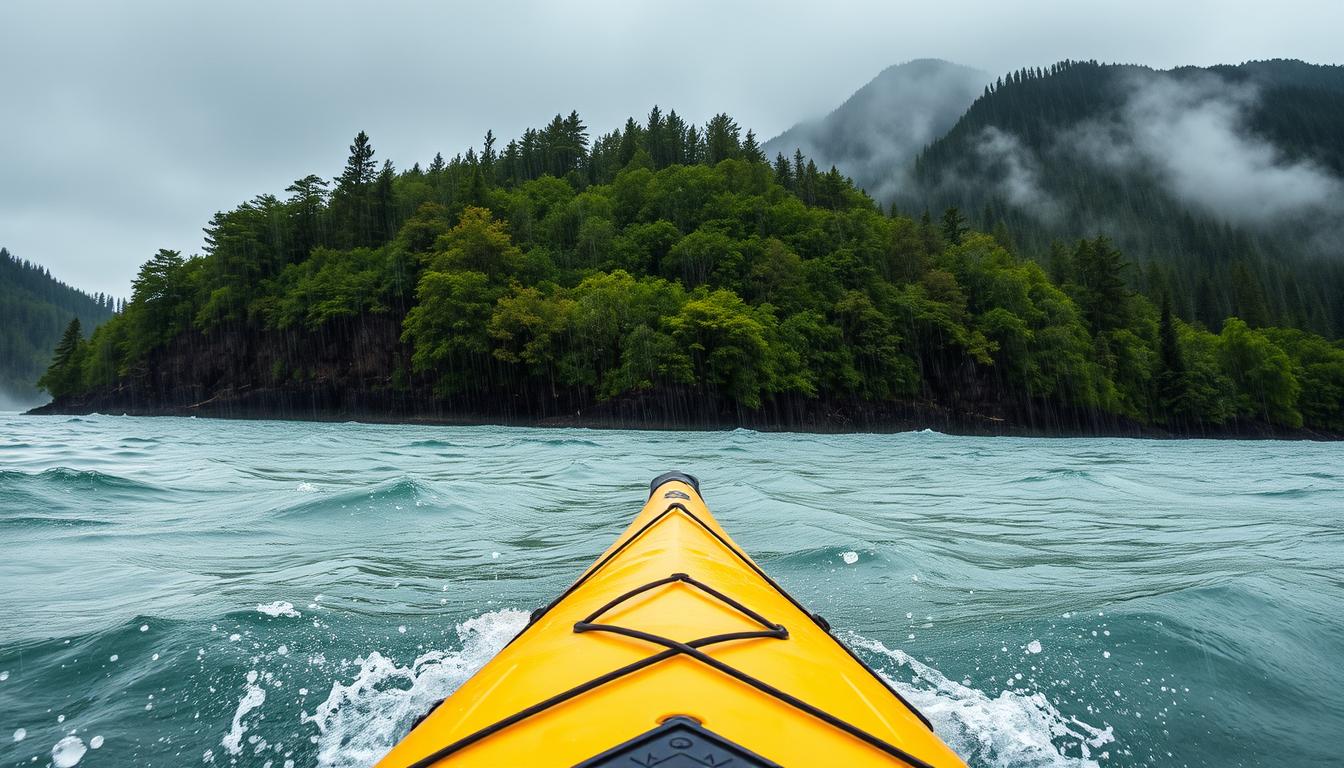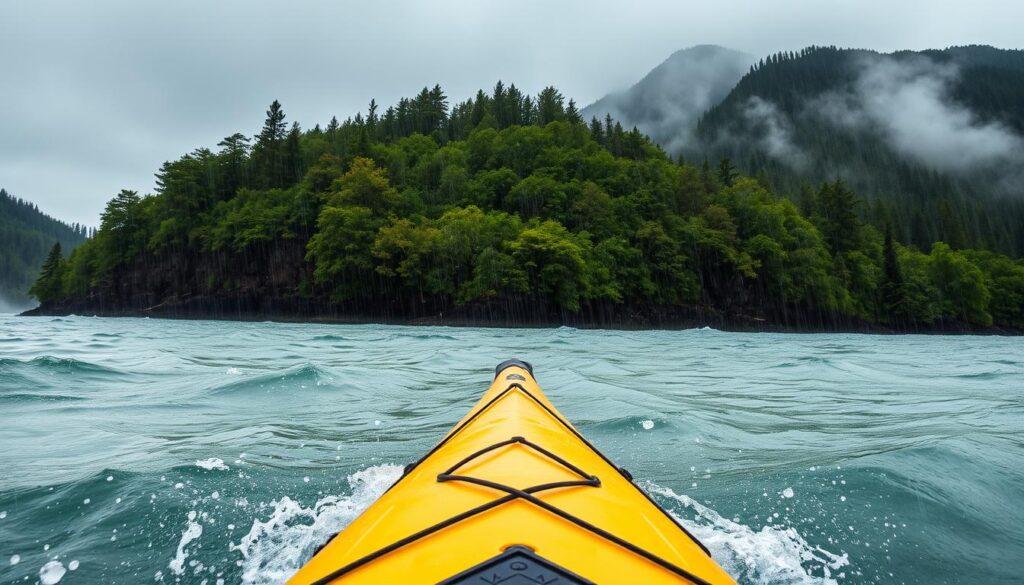
Rainy days aren’t a barrier; they’re a call to an amazing kayaking journey. My first time kayaking in the rain changed how I see outdoor adventures. The raindrops on the water, the sound of rain on my kayak, and the thrill of exploring nature’s waters left a lasting memory.
Kayaking in the rain is not for the faint of heart. It requires careful planning, the right gear, and a bold spirit. This guide will help you navigate the rain safely and with excitement, whether you’re experienced or just starting out.
Adventuring in the rain is more than just knowing how to kayak. It’s about seeing the world from a fresh angle. You’ll find out how to turn a rainy day into an adventure that few dare to try.
Key Takeaways
- Rain doesn’t stop kayaking—it enhances the experience
- Proper preparation is crucial for safe rainy kayaking
- Specialized gear can make wet conditions enjoyable
- Weather understanding is key to successful rain kayaking
- Challenging conditions build stronger paddling skills
Understanding Weather Conditions for Safe Kayak in Rain
Kayaking in the rain needs you to know about weather and safety. You must be able to read the signs of the environment.
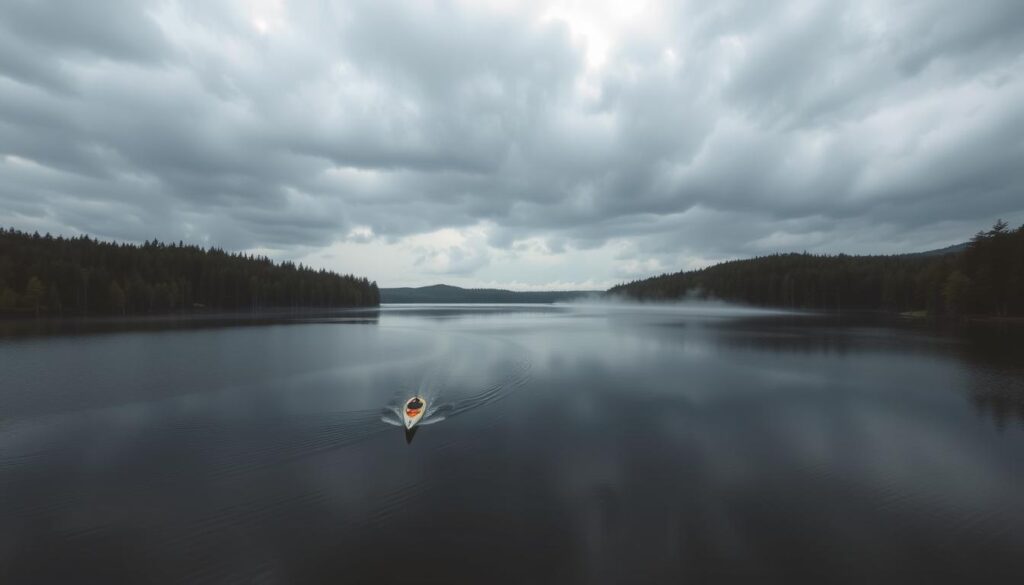
When planning a kayak trip, checking the weather is key. Knowing the risks helps keep you safe on the water.
Reading Weather Forecasts and Patterns
Good kayaking in the rain starts with weather research. Look at:
- Precipitation intensity
- Wind speed and direction
- Temperature variations
- Potential storm systems
“Knowing weather patterns can mean the difference between an exhilarating adventure and a dangerous situation.” – Professional Kayaking Association
Identifying Safe vs. Dangerous Rain Conditions
Not all rain is the same for kayaking. Learn to tell safe from dangerous by checking:
- Rainfall volume
- Thunder and lightning presence
- Water current strength
- Visibility limitations
Monitoring Wind and Water Conditions
Wind and water are key for kayaking safety. Experienced paddlers watch for changes in the water. They stay alert and ready to adapt.
Experts say use many weather sources for a full check before kayaking. This helps ensure a safe trip.
Essential Waterproof Kayaking Gear for Wet Conditions
Getting ready for a rainy kayaking trip means you need the right gear. This gear keeps you dry and comfy. Choosing the best kayaking rain gear is key to enjoying your time on the water.
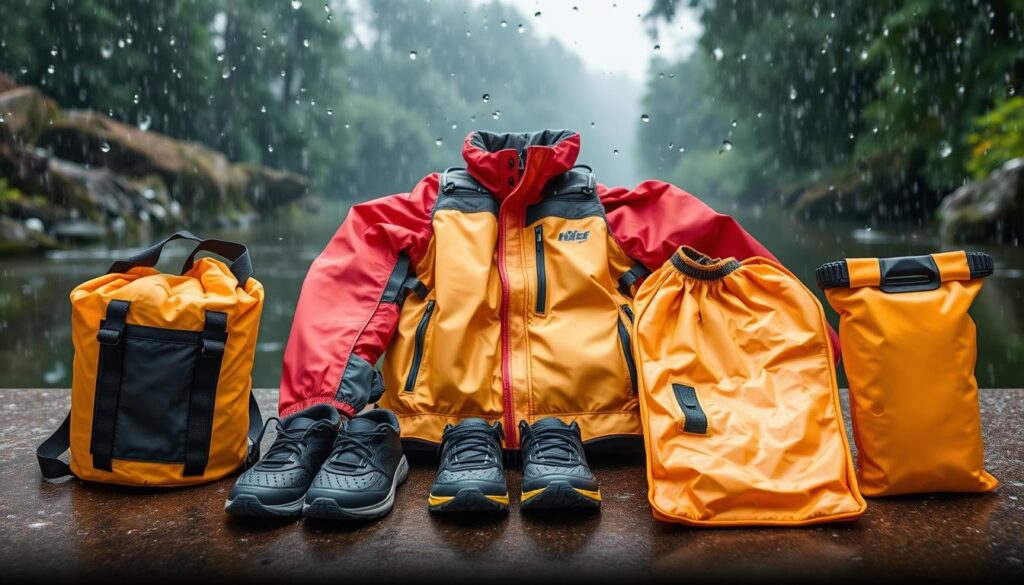
Every kayaker needs the right waterproof stuff to stay safe and have fun. Here are the must-haves for your waterproof kayaking gear:
- Waterproof Jacket: A strong, breathable jacket that keeps water out and lets moisture in
- Dry Pants or Waterproof Trousers: These keep you dry in wet weather
- Waterproof Boots or Shoes: They keep your feet warm and dry, and give you good grip
- Waterproof Gloves: They keep your hands warm and dry
It’s also important to protect your gear. Get high-quality dry bags and waterproof cases for your electronics. This keeps them safe from water damage.
“The right kayaking rain gear can turn a bad day into an exciting adventure.” – Professional Kayaking Instructor
When picking waterproof kayaking gear, look for these important features:
- Breathability
- Water resistance rating
- Durability
- Comfort and mobility
Choosing the right waterproof kayaking gear means you’re ready for wet weather. You’ll be confident and comfortable on the water.
Choosing the Right Rain Protection Equipment
Kayaking in the rain needs smart gear to stay dry and comfy. It’s key to keep water out for a fun paddle. The right gear makes a big difference in your kayaking trip.
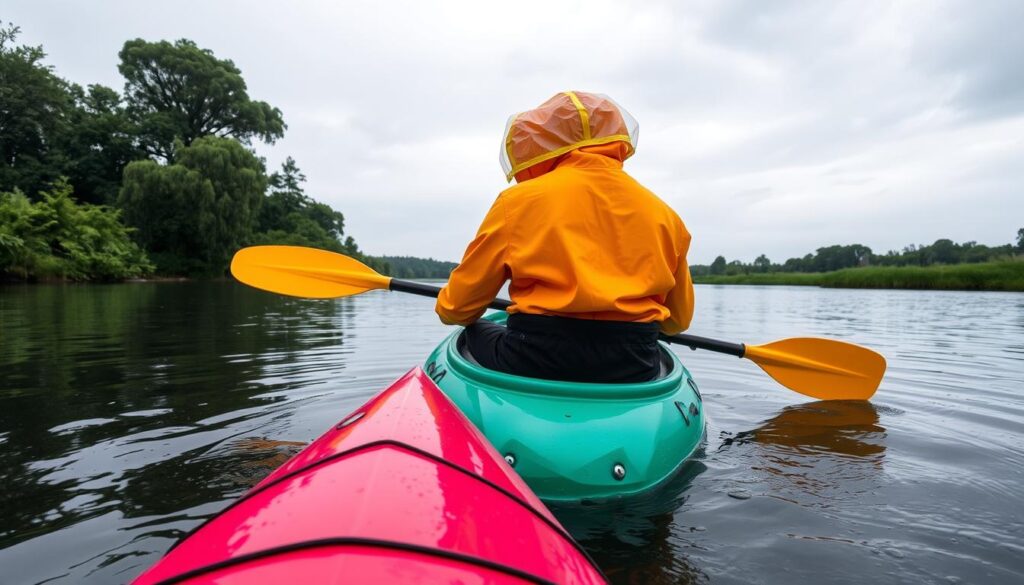
Choosing the right kayak rain covers and splash skirts is important. Think about your kayaking spot and what you need. Your safety and comfort depend on good gear choices.
Selecting Quality Rain Covers
When picking kayak rain covers, look at these things:
- Waterproof material durability
- Proper fit for your kayak model
- UV resistance
- Ease of installation
Proper Splash Skirt Installation
A good kayak splash skirt keeps water out. Here’s how to install it right:
- Make sure the skirt fits your kayak’s cockpit
- Stretch the neoprene or rubber rand evenly
- Make sure it’s tight but comfy
- Test it in water before you paddle
Drysuit vs. Wetsuit Considerations
Deciding between a drysuit and wetsuit depends on the water and your style.
| Drysuit | Wetsuit |
|---|---|
| Completely waterproof | Allows some water absorption |
| Better for cold water | Best for moderate temperatures |
| More expensive | More affordable |
| Layered insulation possible | Limited insulation options |
“The right gear transforms challenging conditions into an epic adventure.” – Experienced Kayaker
Pro tip: Always invest in quality rain protection equipment that matches your specific kayaking needs and skill level.
Safety Protocols for Stormy Weather Kayaking
Stormy weather kayaking requires top-notch preparation and awareness. Your safety is key when paddling in bad weather. Knowing the right safety steps can turn a fun trip into a safe one.
Before you go kayaking in stormy weather, make a detailed safety plan:
- Make a detailed float plan
- Check the weather forecast carefully
- Tell trusted friends about your trip
- Bring emergency communication tools
“Preparation is the key to surviving unexpected challenges on the water.” – Professional Kayaking Safety Instructor
Knowing your skill level is important for kayaking in bad weather. Not everyone can handle tough conditions.
| Skill Level | Recommended Action |
|---|---|
| Beginner | Avoid stormy weather kayaking |
| Intermediate | Practice in controlled environments first |
| Advanced | Proceed with extreme caution and full safety gear |
Important steps for emergency preparedness in stormy weather kayaking include:
- Pack waterproof emergency signaling devices
- Wear a Coast Guard-approved life jacket
- Carry a marine radio or satellite communication device
- Learn and practice self-rescue techniques
Remember, no kayaking adventure is worth risking your life. Always prioritize safety and make informed decisions when facing challenging weather conditions.
Paddling Techniques for Rainy Conditions
Kayaking in the rain is different and needs special skills. When you’re out in bad weather, knowing how to paddle can save you. It’s the difference between a tough trip and a risky one.
Rain changes how water moves, making it harder to paddle. You need to be very aware and skilled to stay safe. Kayaking in rain is all about smart navigation and keeping safe.
Maintaining Control in Rough Waters
When it’s rainy and the water is rough, you need to paddle differently:
- Sit up straight to keep your balance
- Use short, controlled strokes with your paddle
- Stay relaxed but ready to react
- Learn how to brace to avoid flipping over
Visibility Management Strategies
It’s hard to see when it’s raining. Here’s how to stay visible:
- Wear bright clothes or reflective gear
- Use a waterproof light on your head or a navigation light
- Stick to paths you know well in heavy rain
- Stay close to the shore
Emergency Maneuvers in Heavy Rain
Things can go wrong fast when you’re kayaking in bad weather. Being ready is crucial:
“In kayaking, your ability to remain calm and act quickly can save your life.” – Professional Kayaking Instructor
- Learn how to quickly release safety gear
- Practice saving yourself in safe places
- Bring a way to call for help
- Know how to spot changes in water currents
Remember, getting good at these skills takes practice and training. Always put safety first when kayaking in tough weather.
Protecting Your Kayak and Equipment from Rain Damage
Kayaking in the rain needs special care for your gear. Rain can damage your kayak and accessories if not protected. Keeping your gear safe requires a careful maintenance plan.
Preventing water damage starts before you go kayaking. Your rain gear should protect against moisture. Here are key steps to keep your equipment safe:
- Clean your kayak after each rainy trip
- Apply waterproof sealants to key areas
- Store your gear in a dry, controlled environment
- Use covers for long-term storage
Different materials need different protection. Plastic kayaks need a gentle wash, while wooden ones need more care. Check your gear often for water damage or weak spots.
“Prevention is always cheaper than replacement” – Professional Kayaking Experts
Invest in good storage for your waterproof gear. Dry bags, protective cases, and moisture-absorbing packets are essential. Dry all gear right after a rainy trip to avoid mold and damage.
Good maintenance keeps your gear in great shape. This way, you’re always ready for your next adventure, rain or shine.
Best Locations for Inclement Weather Kayaking
Rainy day kayaking needs the right water bodies and routes for safety and fun. Choosing the best spots can turn a tough paddle into a thrilling adventure.
Sheltered Water Bodies for Safe Paddling
Look for safe places to kayak in the rain. Good spots include:
- Inland lakes with little current
- Calm bays with land all around
- Slow rivers with steady flow
Rain-Friendly Kayaking Routes
Choose routes with natural protection and beautiful views. Here are some rainy day kayaking tips:
| Region | Recommended Location | Water Characteristics |
|---|---|---|
| Pacific Northwest | Puget Sound | Sheltered, moderate currents |
| Northeast | Adirondack Lakes | Calm waters, scenic surroundings |
| Southeast | Florida Mangrove Tunnels | Protected waterways |
Emergency Exit Point Planning
Plan routes with many ways to get out. Good planning can save your life in bad weather. Always find:
- Nearby shores for quick landing
- Accessible boat ramps
- Potential shelter spots
“Preparation is the key to enjoying kayaking in challenging weather conditions.” – Professional Kayaking Instructor
Successful rainy day kayaking is about picking the right spots, being ready, and staying alert.
Conclusion
Rainy day kayaking turns a simple water trip into an amazing adventure. Knowing the weather, choosing the right gear, and learning safety tips are key. These steps help you enjoy the ride more.
Going kayaking in the rain is more than just having the right stuff. It’s about respecting nature’s surprises. Every rainy trip is a chance to improve your skills and learn to paddle better. This guide helps you paddle confidently in wet weather.
Always put safety first when kayaking in the rain. Keep yourself safe, watch for signs from nature, and make smart choices about the water. It’s not about beating the rain, but about being smart and safe.
Your kayaking journey doesn’t stop here. Keep practicing, stay up-to-date on weather, and always keep learning. The water is waiting for your next adventure. Are you ready to paddle into the rain?

